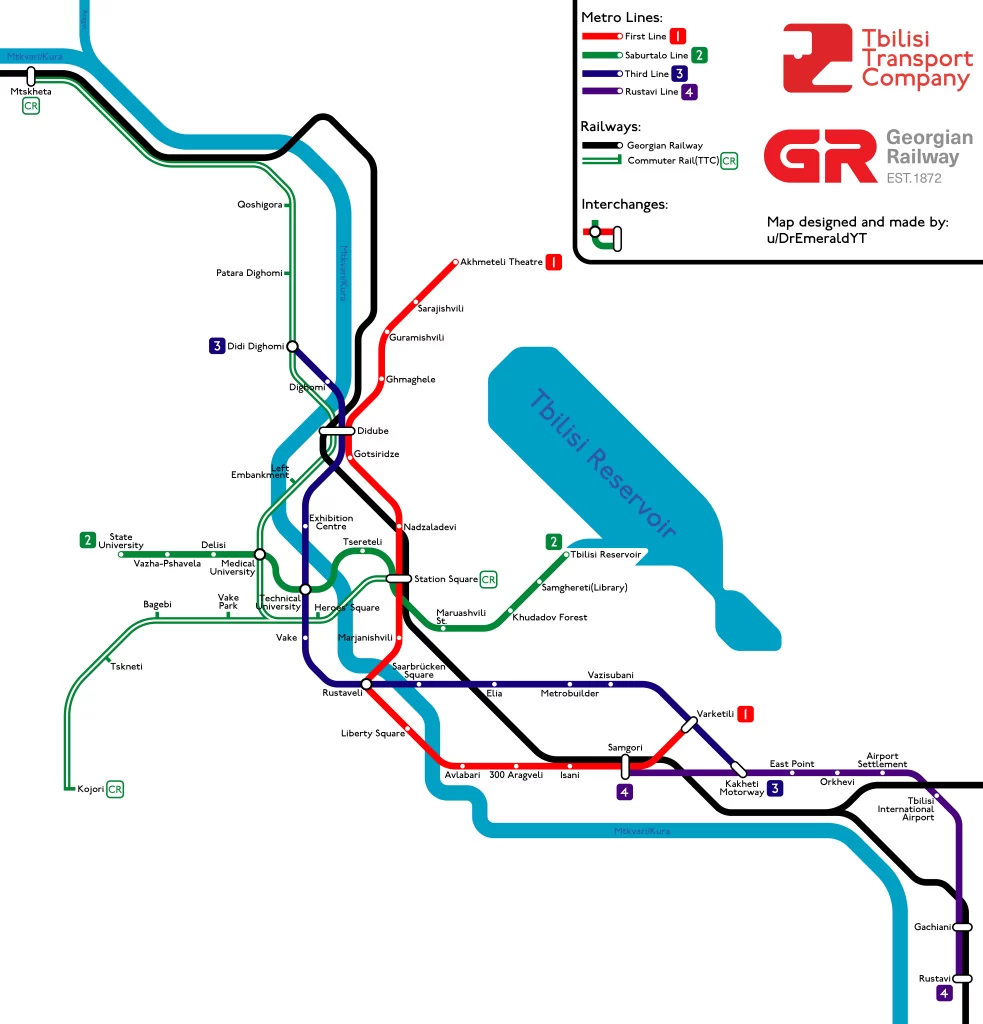The Georgian capital, Tbilisi, has good access to public transportation. A vast network of buses, trams, and the Tbilisi Metro provide service to the city. The 22 stations on the Metro have a frequency of roughly 5 to 10 minutes, and it operates from 6:00 a.m. to 2:00 a.m. There are also buses and trams that operate from 6:00 to 24:00, with a network of more than 200 routes. Additionally, there are various varieties of marshrutkas, or minibuses, that offer a practical means to get around the city. Tbilisi’s public transportation is all reasonably priced and simple to use, making it an excellent way to see the city.
Basic information about the Metro system in tbilisi
Georgia’s Tbilisi metro system makes it easy and efficient to get throughout the city. It opened in December 1966 and is the only metro system in the Caucasus. Currently, it has 22 stations distributed across two lines with a total length of 25.1 kilometers (15.6 miles). With a transfer station at Akhmeteli, the metro lines connect Didube in the city’s north with Varketili in the south. The metro has a starting fare of 0.50 GEL and operates from 6 a.m. to 11 p.m. Additionally, a single-day pass costs 3 GEL, and a ten-ride card costs 5 GEL. Even though the metro system is a fantastic way to get around, it can get very busy during rush hours.
The lines of the Tbilisi subway system
The metro system in Tbilisi, the energetic capital of Georgia, is contemporary and effective. There are 11 lines in the Tbilisi Metro network, which makes getting about the city simple and economical. The network of 37 kilometer-long metro lines is interconnected with one another.
The Akhmeteli-Varketili line, the first metro line in Tbilisi, was inaugurated in 1966. This line runs the length of the city, from the Varketili district in the south to the Akhmeteli district in the north. With over 30 million users annually, it is the busiest line in the system.
The Saburtalo line, Isani line, Rustaveli line, Avlabari line, Didube line, Marjanishvili line, Gldani-Nadzaladevi line, Tsereteli line, Kukia-Samgori line, and Dighomi line are some of the additional Tbilisi Metro lines.
With almost 20 million riders annually, the Saburtalo line is the second-busiest line in the Tbilisi Metro. A north-south route, it connects to the Akhmeteli-Varketili line at the Freedom Square station after passing through the city’s Saburtalo neighborhood.
The city’s Isani district is traversed by the Isani Line, an east-west railroad. At the Avlabari station and the Technical University station, it has connections to both the Rustaveli line and the Akhmeteli-Varketili line.
The Rustaveli line is the third busiest line in the Tbilisi Metro. About 15 million people use it every year. A north-south route, it connects to the Isani line at the Technical University station after passing through the city’s Rustaveli neighborhood.
The city’s Avlabari district is traversed by the east-west Avlabari line. At the Freedom Square station, there is a connection to the Akhmeteli-Varketili line.
The Didube district of the city is traversed by the Didube line, an east-west railroad. At the Freedom Square station, there is a connection to the Akhmeteli-Varketili line.
The Marjanishvili district of the city is traversed by the north-south Marjanishvili line. At the Freedom Square station, there is a connection to the Akhmeteli-Varketili line.
The city’s Gldani and Nadzaladevi districts are connected by the east-west Gldani-Nadzaladevi line. At the Freedom Square station, there is a connection to the Akhmeteli-Varketili line.
The Tsereteli district of the city is traversed by the east-west Tsereteli line. At the Freedom Square station, there is a connection to the Akhmeteli-Varketili line.
The city’s Kukia and Samgori neighborhoods are connected by the north-south Kukia-Samgori line. At the Freedom Square station, there is a connection to the Akhmeteli-Varketili line.
The Dighomi district of the city is traversed by the north-south Dighomi line. At the Freedom Square station, there is a connection to the Akhmeteli-Varketili line.
A quick and economical option to go around the city is the Tbilisi Metro. It is simple to get from one side of the city to the other thanks to the 11 lines. The Tbilisi Metro is the ideal means of transportation for getting around the city, whether you’re going to work, visiting tourist attractions, or simply exploring it.
Map of Tbilisi Metro 2023 – Free Download in PDF

You can now download the Map of the Tbilisi Metro 2023 for free in PDF format. With all of the stations, lines, and connections shown, it is the most thorough and current map of the Tbilisi Metro system. Anyone visiting the capital of Georgia who needs to use the public transportation system quickly will find this map to be a great resource. With the help of the Tbilisi Metro 2023 map, you can navigate the city with ease and avoid getting lost. Start exploring by obtaining your free copy of the map right away.
Public transport tickets in Tbilisi – Best types for travelers & actual prices
Different public transportation tickets have been introduced, making travel in Tbilisi simpler than before. There are many alternatives available, whether you’re looking for a single use ticket or a season ticket. We will go into great detail about the various ticket categories, costs, and purchasing procedures in this article.
The “Metropas” card is the most widely used form of public transportation in Tbilisi. This card is accepted on all city buses, metro trains, and minibuses. The normal card and the discount card are the two varieties that are offered. While the discount card costs only 6 GEL and is only good for 30 days, the ordinary card costs 10 GEL and is only good for 90 days. Both cards can be topped off with the desired amount at any station or kiosk.
The “Trolleybus” ticket is the second type of ticket that is offered. This ticket costs 1 GEL for a single ride and is valid on all city trolleybus routes. Additionally, a 90-day season ticket option is offered, which costs 30 GEL.
The “Bus” ticket is the third type of ticket that is offered. This ticket costs 1 GEL for a single trip and is valid on all city buses. Additionally, a 90-day season ticket option is offered, which costs 30 GEL.
You can also buy a “City Tour” ticket, which permits you to travel on the city’s trolleybus, bus, minibus, and metro services. This ticket has a one-day validity and costs 15 GEL.
Finally, you can get a “City Pass” if you want a more affordable choice. This card is good for 30 days and gives you access to the city’s trolleybus, bus, minibus, and metro services. This pass is priced at 50 GEL.
As you can see, Tbilisi offers a wide variety of choices for purchasing tickets for public transportation. There is something for everyone, whether you’re looking for a single use ticket or a season ticket. At any station or kiosk, you can buy tickets for any event.
We trust that this page has been useful in giving you thorough details on the various ticket categories, their costs, and how to buy them. Travel safely!
Summary of fares for public transport in Tbilisi
- Tbilisi has introduced a variety of public transit tickets, offering options for both season and single-use travellers.
- The “Metropas” card, the most popular type, is available in two variations: the regular card (10 GEL, good for 90 days), and the discount card (6 GEL, valid for 30 days)
- A one-way “Trolleybus” ticket (1 GEL) and a season ticket (30 GEL, 90-day validity)
- A one-way “Bus” ticket (1 GEL) and a season ticket (30 GEL, 90-day validity)
ticket for the “City Tour” (15 GEL, one-day validity)
“City Pass” (50 GEL, 30-day validity)
Timetables & Schedules of Tbilisi Metro system
The Tbilisi Metro system is open every day of the week from 6:00 am to 11:00 night. During peak hours, trains operate every 5 minutes; during off-peak hours, they run every 10 minutes. If at all possible, avoid travelling during peak hours when the trains are typically highly crowded. With more than 30 stations dispersed across the city, the Metro system is well connected to the rest of the city. The Green, Blue, and Red Lines as well as the Purple Line are just a few of the lines that pass through the city. In addition to being the quickest route to many of the city’s major attractions, the Tbilisi Metro system offers a convenient and effective method to navigate around the city.
What Are Other Options For Public Transportation In Tbilisi?
Georgia’s main city, Tbilisi, is a lovely place with lots of things to do and many different ways to get around. There are a number of different options for public transit in Tbilisi for those seeking an alternative to the metro.
The city has regular bus and minibus services, first and foremost. The Tbilisi Transport Company runs buses, while private businesses run marshrutkas, also known as minibuses. These options are fantastic for moving around Tbilisi swiftly and simply because they operate across the entire city.
Additionally, the city has a vast taxi network that includes both traditional taxis and online ride-hailing services like Yandex Taxi, Bolt, and Maxima Taxi. For people who wish to travel swiftly within the city or who don’t want to cope with the metro’s congestion, taxis are an excellent option.
Additionally, Tbilisi has a number of bike-sharing programmes, including EcoBike and Tbilisi Bike Share. With the help of these services, consumers can hire bikes from particular spots around the city and return them anywhere else. For those who like to tour the city on two wheels, this is a fantastic environmentally responsible option.
Last but not least, Tbilisi has its unique take on the traditional tram. The Tbilisi Tram Company runs several trams, which are a convenient method to navigate around the city. They offer a more picturesque path than the buses and are typically more dependable than the metro.
There are many possibilities in Tbilisi for individuals seeking alternatives to the metro. There are many means to get around the city, including buses, minibuses, taxis, and bike-sharing programmes. There is bound to be a choice that meets your preferences, whether you want a simple, quick ride or a more picturesque one.
How To Get From Tbilisi International Airport (tbs) To The City Center With Public Transport?
Using public transportation, getting to the city centre from Tbilisi International Airport is simple and reasonably priced. The route from the airport to the city centre is described in detail here.
- go to the bus station: Make your way to the bus terminal after picking up your luggage from the airport. The bus station is situated right outside the airport and is accessible via a free shuttle service provided by the Tbilisi airport.
- Purchase a Ticket: You’ll need to purchase a ticket when you get to the bus station. At the bus station, there is a ticket counter where you may buy tickets. You can use cash or a credit card to purchase the 1.50 GEL ticket.
3. Board a Bus: You can board the bus as soon as you have your ticket. Depending on traffic, the bus number is 37, and the travel time is roughly 30 minutes. Keep your ticket close at hand in case a ticket inspector requests to examine it.
4. Disembark at City Center: When you see Freedom Square in the city centre, you will know you have arrived where you need to be. From there, you can take a taxi, take another form of public transit, or walk to your hotel or another location.
Public transportation is an easy and cost-effective option to go from Tbilisi International Airport to the city centre. You’ll be on your way quickly if you follow these tips!
What kind of sightseeing DO you have to see if you visit the Tbilisi for THE first time?
The vivacious capital of Georgia, Tbilisi, is a city rich in tradition, beauty, and culture. There is something for everyone to appreciate in Tbilisi, from the city’s distinctive blend of Middle Eastern, Eastern European, and Soviet-era architecture to its thriving nightlife. There are plenty of things to do in the city, whether you want to take a leisurely stroll around the old town’s cobblestone streets or go out for the night at one of the many clubs. You won’t want to miss any of the main sights in Tbilisi, which are listed below.
The Old Town of Tbilisi is among the city’s most visited attractions. There are many meandering cobblestone lanes, obscure alleyways, and magnificent historical buildings in this neighbourhood. The 13th-century Metekhi Church and the Narikala Fortress are only two of the churches, monuments, and other historical structures that can be seen here. This location directly on the Mtkvari River’s banks makes it a perfect site to see some of the city’s best vistas.
You should go to the Dry Bridge Market if you want a distinctive shopping experience. Everything from handcrafted arts and crafts to treasures from the Soviet era may be found in this thriving market. Everything from antique jewellery and furniture to traditional Georgian attire may be found here.
Without a trip to the sulphur baths, a visit to Tbilisi would not be complete. These pools, which are well-liked by both locals and tourists, are reputed to have healing properties. The Orbeliani and Abanotubani Baths are the two main bathhouses, and both of them provide a variety of services such massages, mud therapies, and herbal steam baths.
Last but not least, pay a visit to the Georgia National Botanical Garden. This beautiful park is a terrific place for a leisurely walk through nature and is home to over 8,000 varieties of plants, trees, and flowers.
There are many things to do in Tbilisi, from the energetic Old Town to the therapeutic sulphur baths and the gorgeous National Botanical Garden. There is something for everyone in this dynamic city, whether you’re searching for a tranquil retreat or an exhilarating night out.
Summary of our tour guide for Tbilisi
Georgia’s capital, Tbilisi, is renowned for its rich cultural diversity and magnificent architecture. It is a thriving metropolis with many of opportunities for dining, shopping, and entertainment. Tbilisi has a wide variety of attractions and is well-served by public transportation. The city features a dependable metro and bus system in addition to minibuses, individual vehicles, and taxis. It is simple to navigate around town because to the accessibility and affordability of all public transportation options.
Top 5 FAQs and answers about Tbilisi public transport?
- How does Tbilisi’s public transportation operate?
- Buses, the metro, and minibuses are all public transportation options in Tbilisi. The largest and most comprehensive metro system is in Tbilisi, and it is open from 6 am to midnight. Buses and minibuses circulate all over the city and surrounding area. Since they typically have a blue tint, they are usually simple to identify. A rechargeable card that may be purchased at any metro station is used to pay for fares.
- In Tbilisi, what safety precautions should I take when utilising public transportation?
- Using Tbilisi’s public transportation means putting your safety first at all times. It’s critical to pay attention to your surroundings and to refrain from carrying a lot of cash. Be cautious of pickpockets in busy places and try to travel in groups. Furthermore, it’s crucial to heed staff directions and everything written on the wall.
- How expensive is Tbilisi’s public transportation?
- Yes, Tbilisi’s public transportation is quite reasonably priced. A single trip on the metro, bus, or minibus only costs a few GEL, while monthly passes cost roughly 30 GEL.
- In Tbilisi, are there any discounts for using the public transportation system?
- In Tbilisi, discounts are available for using the public transportation system. On some trips, seniors and students are eligible for savings of up to 50%. It’s also a good idea to check the fares in advance because some days of the week have discounts.
- How can I move around Tbilisi the easiest?
- The most effective way to travel about Tbilisi depends on the traveller. Buses and minibuses are ideal for touring the area, but the metro is the most effective way to get around the city. However, if you want to take a more picturesque route, getting a taxi or renting a car might be your best bet.
Useful links







